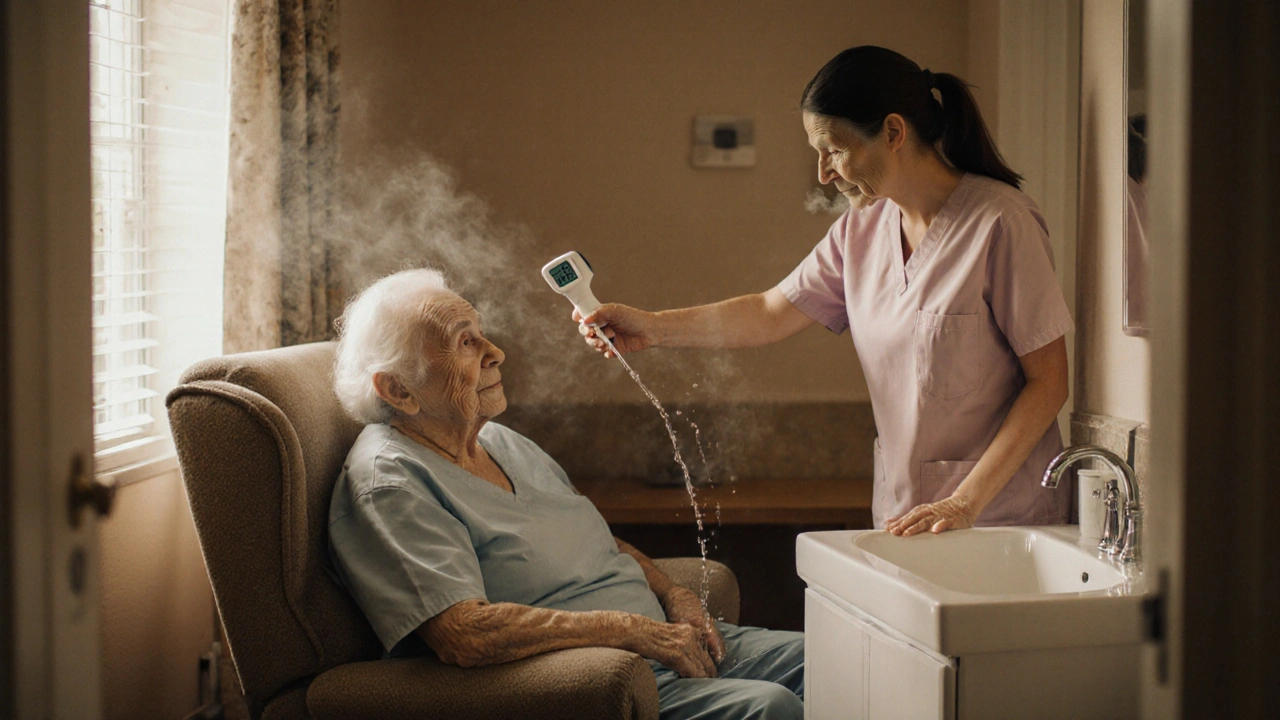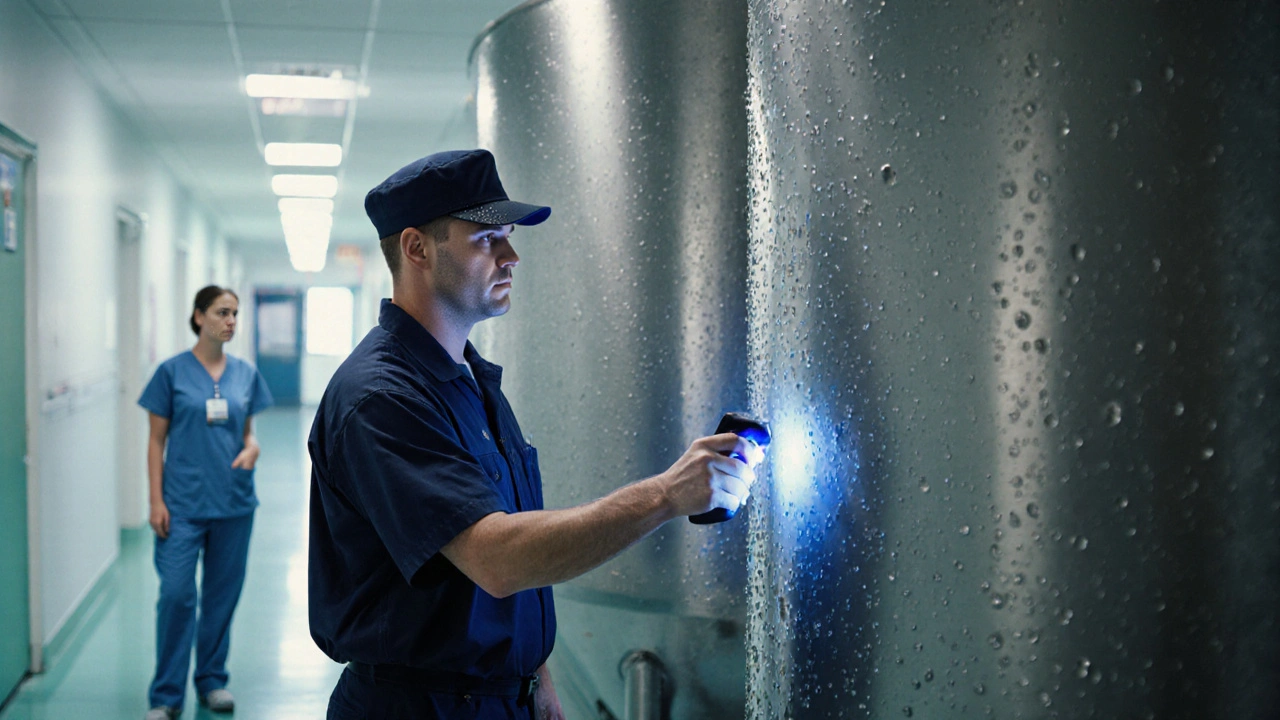Legionnaire's disease is a severe form of pneumonia caused by Legionella bacteria. In recent years, hospitals, nursing homes, and other care sites have seen a disturbing uptick in cases, turning what was once a rare travel‑related illness into a pressing public‑health challenge.
The stakes are high. A single outbreak can affect dozens of vulnerable patients, strain limited resources, and trigger costly regulatory actions. This article walks you through why modern healthcare facilities are prime targets, how to spot an outbreak early, and what practical steps can keep the water in your building from becoming a bacterial breeding ground.
Key Takeaways
- Legionella thrives in warm, stagnant water - common in HVAC and plumbing systems.
- Patients with weakened immune systems are most at risk.
- Rapid diagnosis hinges on urine antigen tests and culture of respiratory samples.
- Proactive water‑management plans cut outbreak risk by up to 80%.
- Compliance with CDC and local health‑department guidelines protects both patients and facility reputation.
Understanding Legionnaire's Disease
Legionella pneumophila is the most common species implicated in human disease, especially in the healthcare setting. The bacterium multiplies in biofilm-a slimy layer that forms on pipe interiors when water temperature hovers between 20‑45°C (68‑113°F). When a patient inhales aerosolized droplets - from a shower head, a cooling‑tower plume, or a humidifier - the bacteria can lodge deep in the lungs, triggering inflammation and fever.
Symptoms usually appear 2‑10 days after exposure and include cough, shortness of breath, muscle aches, and confusion. Because the clinical picture mimics other types of pneumonia, missing the diagnosis can delay appropriate therapy, worsening outcomes.
Why Healthcare Facilities Are Vulnerable
Modern hospitals are complex ecosystems of water distribution, heating, ventilation, and air‑conditioning (HVAC) networks. Each component offers a potential reservoir for Legionella. A few key reasons underpin the heightened risk:
- Water systems are large, often spanning multiple buildings, making temperature control difficult.
- Frequent water stagnation occurs in low‑usage wards, isolated patient rooms, and during building renovations.
- HVAC cooling towers generate fine mist that can travel long distances.
- Older plumbing materials, such as galvanized steel, corrode more easily, fostering biofilm growth.
- Immunocompromised patients-those undergoing chemotherapy, organ transplants, or intensive‑care support-are far more likely to develop severe disease.
Because these facilities must balance patient comfort, infection control, and cost, water‑management programs often fall short of the rigorous standards needed to keep Legionella at bay.
Detecting an Outbreak Early
Speed is everything. The moment a cluster of pneumonia cases appears, an outbreak investigation should be launched. Core steps include:
- Diagnostic testing: Urine antigen tests provide results in hours, while culture of sputum or bronchoalveolar lavage fluid confirms the species.
- Environmental sampling: Swabs from shower heads, faucets, and cooling‑tower water are cultured on selective media.
- Review of water‑temperature logs: Temperatures below 50°C (122°F) in hot‑water loops are red flags.
- Patient chart review: Look for common exposure points, such as shared bathrooms or therapy pools.
Data from the U.S. Centers for Disease Control and Prevention (CDC) show that facilities that implemented a structured infection control program were able to identify outbreaks 30% faster than those without a formal protocol.
Prevention Strategies That Work
The most effective defense is a comprehensive water‑management plan. The CDC’s Guidelines for Preventing Healthcare‑Associated Legionellosis recommend the following core elements:
- System Design Review: Assess new construction for dead‑leg pipes, low‑flow fixtures, and temperature‑control zones.
- Temperature Control: Keep hot water above 60°C (140°F) and cold water below 20°C (68°F). Use thermostatic mixing valves where scalding risk exists.
- Regular Flushing: Implement a schedule to flush low‑use outlets at least weekly, raising water temperature to kill any lurking bacteria.
- Disinfection Protocols: Thermal shock (raising water temperature to 70°C for a short period) or chemical disinfectants (chlorine dioxide, monochloramine) can reduce biofilm loads.
- Monitoring and Documentation: Keep detailed logs of temperature readings, flushing activities, and any corrective actions taken.
Facilities that adopted these measures reported a 70‑80% decline in Legionella detection over a three‑year period, according to a 2023 study of 45 U.S. hospitals.

Responding When an Outbreak Happens
If environmental testing confirms Legionella, an immediate response is vital:
- Hyper‑thermal disinfection: Raise water temperature to 70°C and circulate for at least one hour.
- System‑wide shutdown of affected cooling towers and treatment with approved biocides.
- Temporary relocation of high‑risk patients from the contaminated wing.
- Communication with public‑health authorities and transparent updates to staff and families.
- Review of antibiotic therapy protocols: Macrolides (azithromycin) and fluoroquinolones (levofloxacin) are first‑line treatments for Legionella pneumonia.
Post‑outbreak, conduct a root‑cause analysis. Was there a lapse in flushing? Did temperature sensors malfunction? The findings feed back into the water‑management plan, preventing recurrence.
Legal, Regulatory, and Accreditation Considerations
Beyond patient safety, facilities face legal exposure. In many jurisdictions, a confirmed Legionella outbreak triggers mandatory reporting to health departments. Failure to comply can result in fines, loss of accreditation, and costly lawsuits.
Key regulatory bodies include:
- CDC’s National Healthcare Safety Network (NHSN) - tracks infection rates.
- Joint Commission - requires water‑safety standards for accreditation.
- State health departments - often have specific reporting timelines (usually 24‑48hours).
Documenting compliance not only satisfies inspectors but also builds trust with patients who increasingly scrutinize a facility’s infection‑prevention record.
Looking Ahead: Emerging Technologies
Technology is reshaping how hospitals monitor water safety. Real‑time temperature sensors linked to building‑management systems can flag deviations instantly. Some facilities are piloting DNA‑based rapid testing (qPCR) that detects Legionella DNA in water within hours, far faster than culture.
Another promising avenue is the use of copper‑silver ionization, which continuously releases antimicrobial ions into the water flow, maintaining low bacterial counts without frequent chemical dosing.
While these tools add cost, the potential to avert an outbreak-and the associated human and financial toll-makes them a worthwhile investment for forward‑looking institutions.
Conclusion
Legionnaire's disease is far from a relic of the past; it is a modern threat that exploits the very infrastructure that keeps hospitals running. By treating water as a critical component of patient safety, implementing rigorous monitoring, and staying abreast of emerging disinfection technologies, healthcare leaders can protect vulnerable patients and preserve their facility’s reputation.
Legionnaire's disease may be a growing concern, but with the right strategies, it doesn’t have to become a crisis.
| Reservoir | Typical Temperature Range (°C) | Control Measures |
|---|---|---|
| Hot‑water distribution | 35‑55 | Maintain >60, weekly flushing, thermal shock |
| Cooling towers | 20‑45 | Biocide dosing, routine cleaning, temperature monitoring |
| Showers & faucets | 30‑45 | Point‑of‑use filters, regular disinfection |
| Medical‑device water reservoirs (e.g., humidifiers) | 20‑40 | Daily cleaning, sterile water use |
| Decorative fountains | 25‑35 | Frequent water changes, chlorination |
Frequently Asked Questions
What are the first symptoms of Legionnaire's disease?
Early signs include cough, fever, chills, muscle aches, and shortness of breath. Gastrointestinal symptoms like nausea can also appear.
How is Legionella different from other bacteria that cause pneumonia?
Legionella grows best in warm, stagnant water and spreads through aerosolized droplets, whereas many other pneumonia‑causing bacteria are transmitted directly from person to person.
Can regular plumbing maintenance prevent an outbreak?
Yes. Routine flushing, temperature control, and removal of dead‑leg pipes drastically reduce the chance of Legionella colonization.
What testing method provides the fastest diagnosis?
The urine antigen test returns results within a few hours and is widely used for rapid screening.
Are there any vaccines against Legionella?
Currently, no licensed vaccine exists for humans, making prevention through water management the primary defense.

cris wasala
September 28, 2025 AT 01:03Keep those water temps high and the patients safe.
Tyler Johnson
October 5, 2025 AT 13:36Implementing a water‑management plan is not merely a checkbox activity but a comprehensive, interdisciplinary effort that starts with engineering design and ends with daily housekeeping.
When new wings are constructed the design team must map out dead‑leg pipes, low‑flow fixtures, and zones where temperature control is problematic.
These maps then become the foundation for a risk‑based sampling schedule that targets high‑risk outlets such as showers in intensive care units.
Temperature monitoring devices should be calibrated regularly, because a drift of even two degrees can shift a hot‑water loop from lethal to permissive for Legionella.
The data collected from these sensors must be logged in a central database, enabling trend analysis that can flag a gradual cooling trend before it becomes an outbreak trigger.
In addition to temperature, administrators should audit disinfectant residuals, especially when chemical treatments like monochloramine are employed.
Staff training is essential; nurses and environmental services personnel need to understand how to conduct a proper flush, raise the water temperature to at least 70 °C, and document the action.
Documentation is not an administrative burden but a legal safeguard that demonstrates compliance with CDC guidelines and Joint Commission standards.
Rapid diagnostic testing, such as urine antigen assays, should be made available on the front line so that clinicians can initiate appropriate macrolide or fluoroquinolone therapy without delay.
When a cluster of pneumonia cases is identified, infection control must mobilize an outbreak team that includes microbiology, facilities, and clinical leadership.
Environmental samples should be collected from the most plausible sources, including shower heads, faucets, cooling‑tower basins, and any point‑of‑use water devices.
The laboratory results, combined with patient exposure histories, enable a root‑cause analysis that can pinpoint a specific reservoir.
Once the source is confirmed, a hyper‑thermal shock or targeted biocide application can eradicate the colonizing Legionella population.
After remediation, the facility must verify eradication through follow‑up sampling and reinforce the flushing schedule to prevent re‑colonization.
Ultimately, the success of these measures is reflected in reduced infection rates, lower legal exposure, and the confidence of patients who know their water is being vigilantly protected.
Annie Thompson
October 13, 2025 AT 02:10Reading through the data you can almost feel the quiet anxiety that builds in a ward when an invisible threat lurks in the pipes it is a reminder that even the most sterile environments are vulnerable the stakes feel personal especially for immunocompromised patients whose bodies are already fighting a battle and the thought of another invisible enemy can be overwhelming the best defense is knowledge and proactive measures that turn fear into actionable steps the article captures that urgency and gives a roadmap that can save lives.
Parth Gohil
October 20, 2025 AT 14:43From an engineering perspective the integration of the Building Management System with real‑time thermocouple data creates a closed‑loop control that can autonomously adjust set‑points to stay above the Legionella growth threshold this kind of predictive maintenance, often referred to as condition‑based monitoring, reduces manual flushing cycles and optimises energy consumption while maintaining microbial safety – a win‑win for facilities engineering and infection control teams.
VAISHAKH Chandran
October 28, 2025 AT 03:16This is basic water hygiene and anyone with a modicum of scientific literacy should already be practising it.
Pat Merrill
November 4, 2025 AT 15:50Oh sure the CDC guidelines are just a suggestion – definitly not something you need to follow if you enjoy drama in your hospital corridors.
Vicki Roth
November 12, 2025 AT 04:23That's a solid point.
Vishal Bhosale
November 19, 2025 AT 16:56It is not that hard to keep water hot enough.
Garima Gauttam
November 27, 2025 AT 05:30While the checklist approach sounds comprehensive it often overlooks the nuanced ways in which local water chemistry can render standard temperatures ineffective.
Georgia Nightingale
December 4, 2025 AT 18:03Honestly the only thing missing from all these recommendations is a clear chain‑of‑command that holds someone accountable when a lapse occurs; otherwise you’re just rearranging deck chairs on the Titanic of hospital water safety.